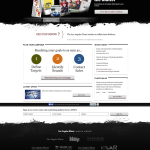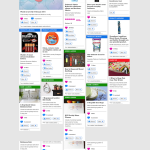Your company is launching a new product this summer. As a marketer, you want to make a huge splash and not just a toe-dipping announcement. You’re killing yourself brainstorming ways to garnish the attention you need so that this launch is a success and your product is well received by the media, bloggers, and potential buyers.
Social media, blogger outreach, and online advertising are all great ideas, but every idea you come up with always sends web traffic back to your boring corporate website. The website that has grown year after year and that is now a big ball of information that leaves you uninspired.
You look at your corporate website with sadness, knowing, no matter what you do, is just won’t create the excitement and attention you need for a successful product launch.
Before you give up your marketing dreams, consider using a microsite built in WordPress.
What is a Microsite?
A microsite is a small group of pages that is designed as a separate web asset for an existing corporate website. A microsite can be housed on a unique URL (www.domainname.com) or on a subdomain (microsite.maindomain.com).
The goal of any microsite is to segregate itself from the main corporate website, thus providing a separate web experience for visitors. WordPress, and all of it’s open source goodness, offers a great solution for creating corporate microsites.
Why Would a Marketer Want a Corporate Microsite?
While there are a host of uses for WordPress microsites, some of the common utilizations include:
- New product launches
- Direct marketing campaigns
- Pay per click campaigns
- Competitions or contests
- Market research
- Seasonal promotions
- Event or conference promotion
- Recruitment
- Employee outreach
In each of these scenarios, WordPress offers a unique experience for website visitors. It helps provide clear messaging on a specific topic and to a very targeted audience.
Benefits of a Microsite
- Highly focused on a given target demographic, visitor persona, and product or service
- Allows marketers to focus on the visitor and not on unnecessary content
- Provides an opportunity for designing a unique look and feel
- Allows for separate navigation from main website
- Provides ease of use for website visitors
- Allows marketers to closely tie the website’s branding to other elements of the marketing campaign
- Removes the unnecessary distractions inherent in a corporate website
- Focuses on specific call to actions
- Provides an avenue for lead generation
- Can evoke a sense of community
- Allows for experimentation
Why is WordPress Ideal for Microsites?
- Flexibility
- Rapid deployment
- Feature rich
- Content easily added or edited by marketing personnel
- Easily integrates with social media
- Does not consume internal resources
- Inexpensive to maintain
Some Excellent Examples of Effective Microsites
While not all of these examples are WordPress websites (a large number of these are WordPress websites) , they all show just how effective microsites can be in luring in visitors, creating a connection, and reinforcing branding.
Stop Stressing and Start Digging into WordPress
When it’s time for your next event, product launch, or contest promotion – consider a WordPress microsite to help you stand apart from the competition. With WordPress you don’t need to worry about internal resource constraints, budgets, and timing. You just need to focus on your marketing message.
















So do you recommend setting up these sites on their own domain, or as a sub domain?
I have heard a lot about the benefits of keeping all of your information and resources on the same domain.
Also, I have seen the individual benefit of having micro niche sites that focus on very specific products, or goals. These sites are very well at converting and bringing in traffic.
But does having different domains and websites for one company complicate the business as a whole? Does it spread out the image to customers?
These are important questions to ask before you branch into micro sites and I know there are a lot of varying opinions from leading experts.
Cheers!
Honestly I don’t think there is a one answer fits all here. I think it would depend on the situation and the organization’s intended use of the microsite.
If the microsite is closely tied to the main corporate site, a subdomain might work best. If it is completely unique type of site that will be used in social media and advertising, then a short and unique URL would be better.